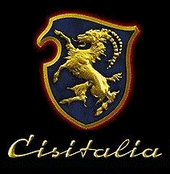.
Cisitalia
Search By Model |
| Defunct |
The name "Cisitalia" derives from "Consorzio Industriale Sportive Italia", a business conglomerate founded in Turin in 1946 and controlled by the wealthy industrialist and sportsman Piero Dusio. Cisitalia was a Formula One constructor from Italy. Piero Dusio participated in a single grand prix, driving a Cisitalia 360. See also Porsche 360.
Cisitalia D46 and 360
Using Fiat parts as a base Dante Giacosa designed the very economical racer, which make its successful debut in 1946. The D46, the small racer featured a simple, but sturdy space frame chassis. Giacosa had vast knowledge of Fiat bits and pieces, as he had designed the legendary 500 Fiat Topolino before the War. The engine and suspension were directly derived from the small Fiat, but extensively modified for their racing purpose. The engine received dry sump lubrication and further tweak considerably increased the power output. Weighing under 400 kg the 60-70 bhp available was more than enough for competitive performance.
Dusio's dream of a one model series came to nothing, but instead his D46s started to dominate the voiturette series. Highly talented drivers like Tazio Nuvolari piloted the D46 to multiple successes against more advanced, but older racing cars. The successes led to a much more ambitious single seater project that would prove too much for the small company. Ferdinand Porsche's Design Studio was commissioned to design and construct a full Grand Prix racer, which had the overly complex, but very interesting Type 360 as a result.
The Cisitalia 202 - A masterpiece of modern art and automotive design
Dusio commissioned several automobiles from Europe's leading designers. He provided Pinin Farina with the chassis on which the Cisitalia's body was placed. The body was more or less handcrafted, with its aluminum panels shaped over wooden forms. Because of this time-consuming process, only 170 models were produced between 1947 and 1952. When first presented to the public at the Villa d'Este Gold Cup show in Como, Italy, and at the 1947 Paris Motor Show, the Cisitalia "202" GT was a resounding success. The two-seater Cisitalia "202" GT was an aesthetic and technical achievement that transformed postwar automobile body design. The extraordinary Pinin Farina design was honored by New York's Museum of Modern Art in 1951. In the MOMA's first exhibit on automotive design, called "Eight Automobiles", the Cisitalia was displayed with seven other cars (1930 Mercedes-Benz SS tourer, 1939 Bentley saloon with coachwork by James Young, 1939 Talbot-Lago Figoni teardrop coupé, 1951 Willys Jeep, 1937 Cord 812 Custom BeverlySedan, 1948 MG TC, and the 1941 Lincoln Continental coupe).
Building on aerodynamic studies developed for racing cars, the Cisitalia offers one of the most accomplished examples of coachwork (the automobile's body) conceived as a single shell. The hood, body, fenders, and headlights are integral to the continuously flowing surface, rather than added on. Before the Cisitalia, the prevailing approach followed by automobile designers when defining a volume and shaping the shell of an automobile was to treat each part of the body as a separate, distinct element—a box to house the passengers, another for the motor, and headlights as appendages. In the Cisitalia, there are no sharp edges. Swellings and depressions maintain the overall flow and unity, creating a sense of speed.
The Cisitalia 202 MM
Since the 202 never made large scale production and all the cars were handmade, the small talented group at Cisitalia, including Carlo Abarth, Dante Giacosa and Giovanni Savonuzzi, made several variants of the 202. Of the more important versions, the SMM Nuvolari Spider was built and named after a class victory at the 1947 Mille Miglia. It is easily identified by its large rear fins, twin windscreens and usual Italian blood red paint scheme.
Partly due to expensive construction of the mid-engine, four wheel drive formula one car, designed by Ferdinand Porsche, Cisitalia went into receivership in 1949 and was sold in 1952. In total, around 200 cars were made which made a large impact on the later marques, including Abarth's later range of cars.
The Cisitalia 202 SMM
For the upcoming 1947 season, Giovanni Savonuzzi, who had designed most of the 202, sketched a coupe body for Cisitalia's competition car. The design was executed by Stabilimenti Farina upon both chassis #101 and #102. After two coupes had been finished, a spider version, Called the SMM for Spider Mille Miglia, was completed which would adorn all subsequent competition cars bearing the MM designation.
At the 1947 Mille Miglia, the Cistitalia spider really proved itself by leading most of the race in capable hands of Tazio Nuvolari. Despite having competition with engines three times larger, Nuvolari held back the competition until troubles ensued in the rain. In the end, the Cistitalia took second overall and first in class. For this epic effort, subsequent competition spiders were known as 202 SMM Nuvolaris.
Since the 202 SMM received much attention at the Mille Miglia, Stabilimenti Farina continued production of the design for several customers. In total around 20 cars were made very similar to Nuvolari's winning car.
Complete Formula One results
| Yr | Main drivers | 1 | 2 | 3 | 4 | 5 | 6 | 7 | 8 |
|---|---|---|---|---|---|---|---|---|---|
| 1952 | P.Dusio | SWI | IND | BEL | FRA | GBR | DEU | DUT | ITA |
See Also
External links
Cisitalia Official Site
Cisitalia Club of North America
Museum of Modern Art New York

